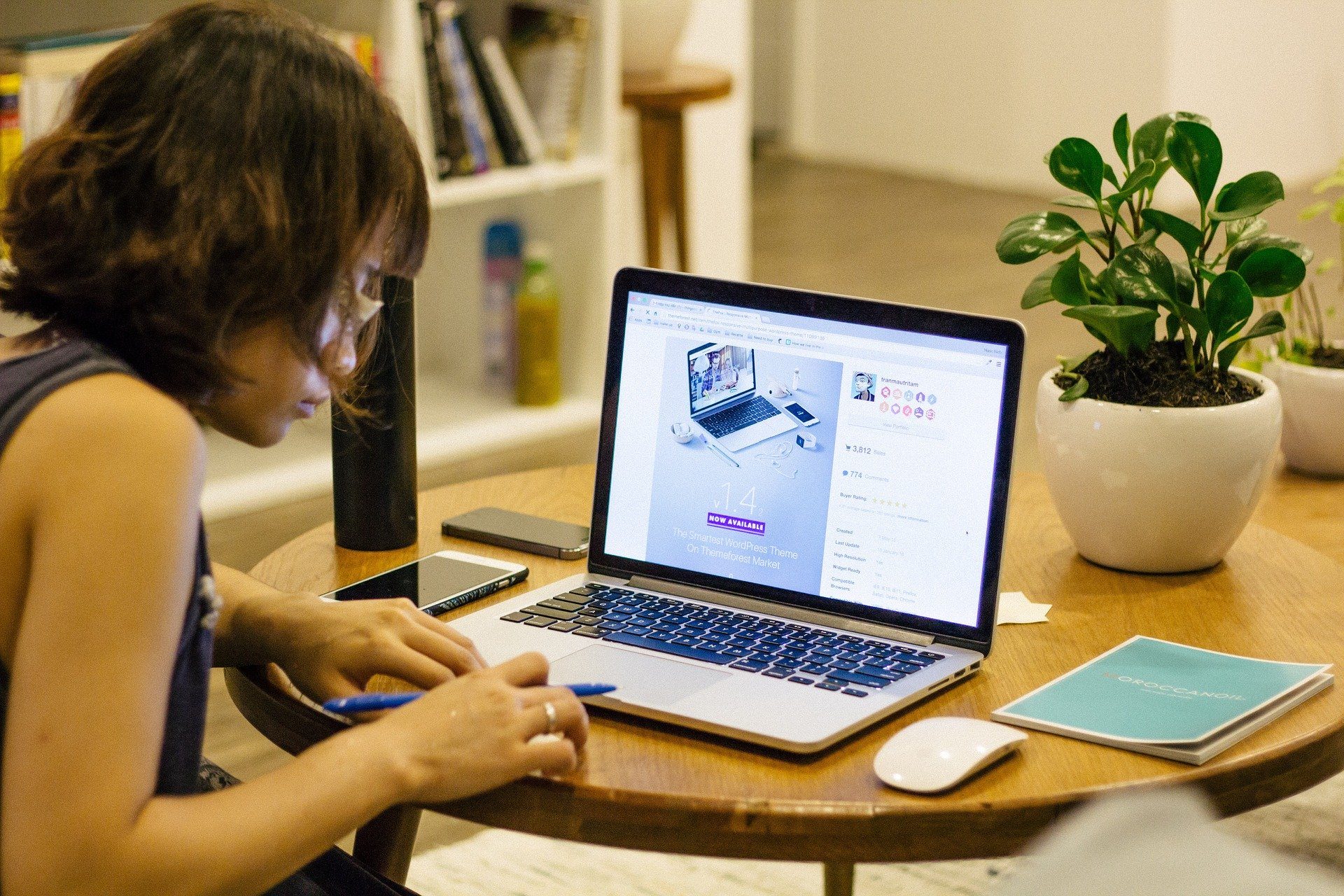As companies think about their post-lockdown work environments, HOK’s Kay Sargent examined the implications of potential expansions to formal work-from-home programs.
Many company leaders have recently realized that, when push comes to shove—or when COVID-19 leads to self-quarantine—their people can be effective working from home. Now many are exploring the idea of permanently increasing the mobility of their workforce.
Remote work is not new. Before the coronavirus pandemic, Gallup’s research tells us that 43 percent of employees were already performing some of their work remotely—and that number has been rising for several years. Yet before COVID-19 catalyzed this massive work-from-home experiment, many employees still felt encumbered by invisible strings tying them to a physical workplace. Now many employers and their managers have realized that remote work really is viable.
The benefits of working remotely are well-documented. Employees reclaim precious hours in the day by eliminating commutes. They have more flexibility in how and when to work and can find more balance between their personal and professional lives. They save money on everything from transportation to their wardrobes.
For employers, offering more work mobility can be a powerful tool for recruiting and retaining the best people. When geography isn’t a limitation, the talent pool grows exponentially. They also have the potential for significant real estate and facility cost savings while having more flexibility to adapt to dynamic business conditions.
There are obvious environmental benefits, too. When fewer employees commute to the office, a company’s carbon footprint shrinks. As a company’s space portfolio gets smaller, it consumes fewer natural resources.
That all sounds wonderful. Like our parents used to admonish us, though, “Just because you can do something doesn’t mean you should.”

Who Should Work From Home?
Distributed work is not right for everyone. The degree that people work remotely should be based on their job function, personality and ability to effectively do so while supporting their organization’s business needs.
The ideal candidates perform a lot of heads-down, individual work that doesn’t require many in-person meetings. They are comfortable communicating via email, phone or messaging programs. They may primarily work with others who also are remote or off-site. Their work may require them to keep an irregular schedule or frequently travel.
Ask yourselves these questions when determining whether specific employees are suited for remote work:
- Can they be effective in performing all their job functions?
- Are they predominantly doing solo work or engaged in team activities, group ideation and collaborative creative pursuits?
- Are they in sales or consulting roles?
- Do they have the right personality type, self-discipline and motivation?
- Can they establish boundaries between work and home life?
- Does their manager have the ability to manage and maintain the trust of a distributed team?
- Do the employees have the ability to set up home workspaces that offer proper ergonomics?
- Do they have the right technology, tools and connectivity to be available and readily access all the company’s resources as needed?
- Will remote work have an impact on connectivity within the organization or erode the organization’s culture?
Digging Deeper Into Organizational Considerations
Here are more considerations for leaders assessing the viability of a remote work program for their companies:
- Organizational structure: If an organization is hierarchical and tends to manage by “presence not performance,” remote working may be a challenge. If a company is entrepreneurial and empowers its workers, offering employees more flexibility and mobility may be a natural next step.
- Corporate culture: Trust is a key component of every successful remote work policy. If an organization doesn’t already have an optimal level of trust with employees, remote work could strain that relationship. And if not implemented in a thoughtful, strategic way, imposing a remote work policy on a successful workforce could harm its culture.
- Demographics: For the past decade, Millennials drove the push for greater flexibility in where and how they work. Yet we also have learned that they like to come together. As charter members of the ‘we-volution,’ they seek out opportunities to interact. However, Gen Xers and Baby Boomers who are long inured to working in offices also value distributed work programs. They often have kids or aging parents and are more likely to live in the suburbs, with longer commutes to the office. They frequently have already established themselves within an organization and built their networks and relationships. Many realize they will likely need to work longer than originally expected and feel they have earned some latitude about where they perform this work.
- Regional influences: For many companies, the decision to embrace a distributed work program is heavily influenced by local transportation mobility and traffic congestion. In large cities, the opportunity for workers to save time, money and energy by avoiding a long commute can be significant. For companies with facilities located in more suburban or rural locations, the commute time may be less relevant. What works in Central London won’t necessarily apply in the suburbs of Kansas.
- Employee work styles: If an organization is focused on sales and consultative services and employees spend a lot of time outside the office, remote work could be very effective. The flip side is that more creative organizations tend to thrive on the sharing of ideas ignited in an office setting. That collective energy can be critical to innovation. It’s also true that teams that know each other on a more personal level tend to build stronger bonds, and that body language is a vital part of communication.
Remote Control: Finding the Right Balance
During this time of self-quarantine, many people who are no longer commuting to the office report that they’re spending that extra time working. This translates to more sitting inside, less movement and an overall more sedentary lifestyle with negative health implications. With no separation between work and home, some have trouble putting their work aside and are feeling like they always have to be “on” and available to their teams and customers. There also are plenty of distractions at home, including kids, roommates, deliveries, dogs, never-ending piles of laundry or the TV. Other people, particularly extroverts, feel isolated and long for the energy boost they feel from being around others. As social creatures, they miss the connections and interactions with their coworkers. All this adds up to the idea that while people may have a fresh appreciation for their ability to work from home, this may not be what they want to do five days a week.
The ability for people to physically come together remains important. Most companies will always need a place where they can accommodate those who cannot work from home, either for work or personal reasons.
In a post-pandemic era, though, the purpose of the workplace will likely shift. Instead of requiring people to come to an assigned space every day, more organizations will conclude that a mix of working from home and coming together in the office is the best solution.
By the Numbers
In recent years, many companies have increased employee mobility as a method of accommodating growth without taking on additional square footage. Now, many see expanding their remote work programs as an opportunity to reduce space and associated costs. Yet asking people to work remotely just one or two days a week doesn’t always equate to space or cost savings, because this doesn’t necessarily reduce the number of work points needed in an assigned office environment.
It’s when employees start to work remotely three days a week and organizations transition to unassigned desking that real gains from reducing costs and space can be realized. This type of strategically deployed distributed work program can enhance recruitment and retention, boost productivity, and reduce absenteeism and real estate costs. These factors alone can save a typical employer an average of $11,000 per half-time remote worker per year.
From a purely bottom-line perspective, the economics of mobility are clear: a need for fewer permanent workspaces equates to a need for less square feet. But these savings can only be realized if the space can be released.
Consider a company with 100 office workers. Using the traditional model of a desk-to-worker ratio of 1.10:1, this enterprise would need 110 desks. At 160 RSF per work point, that comes to about 17,600 RSF. At $60/RSF, the annual cost for rent alone is $1,056,000. Simply changing that ratio to 1:1.33 for the entire staff would save them 25 work points, which equates to 4,000 RSF and $240,000 in annual rent. Cut that desk-to-worker ratio even deeper to 1:1.5 and the annual rent savings jump to $480,000. Factor in operations and parking costs and the potential savings are even more significant.
Density, Utilization and Physical Distancing
The COVID-19 pandemic has heightened people’s sensitivities around density and proximity. Moving forward, companies will be looking for ways to help their people feel safe by allowing for physical distancing in the workplace. In offices with space that is currently underutilized, creating physical distance between desks will be relatively easy. For companies with higher density and space utilization, a remote work program will likely be part of a strategy for freeing up the required space for physical distancing.
Flexible Operations
Buildings are typically designed for a static number of occupants. But looking ahead to the increasing legions of mobile workers, there could be 50 people in the office one day and 150 the next.
Companies will need to assess their parking requirements, office hours, security needs, HVAC and lighting systems, and employee services and amenity spaces—from dining to exercise facilities—to meet new demands.
The challenge will be designing for building operations and services that can support this variability.
More, Less and the Big Shift
Another way to look at the potential benefits of distributed work is by asking, “What does it give us more of? What does it give us less of? And what does it change?”
Distributed work can increase:
- Productivity
- Opportunities for deep concentration and mindfulness
- Access to talent
- Flexibility
- Employee control
- Employee satisfaction
- Work-Life balance
Distributed work can decrease:
- Stress and burnout
- Presenteeism
- Redundancy
- Underutilized space and vacancies
- Overall real estate needs
- Dependence on the office
- Commute times
- Environmental impact
Distributed work can shift:
- The ratio of dedicated to shared space
- Dependence on paper files to electronic
- Managing by presence to managing by performance
Though we can’t predict the future, we can plan for the possibilities. COVID-19 is generating opportunities to change the way we work going forward. The norms are changing, and the effects of worker mobility will ripple through society in ways that will continue to surprise us.
Again, just because you can do something doesn’t mean you should. When weighing decisions about changing your approach to remote work, avoid knee-jerk reactions to the current crisis. Instead, we recommend that you consult with a workplace planning partner to make sure your actions are part of a carefully considered strategy that meets the long-term needs of your people and organization. If you need any advice on how to get started, please don’t hesitate to reach out. We’re here to help.
About this series: HOK workplace design leaders are sharing their thoughts and client insights about the state of today’s work environment and how it will adapt to the new coronavirus realities.
-
- Part 1: This Is No Ordinary Time for Remote Working
- Part 2: What Will Be the COVID-19 Takeaways for the Workplace?
- Part 3: Lessons Learned From Construction Markets First Hit by Coronavirus
- Part 4: COVID-19 and the Case for a Hands-Free Workplace
- Part 5: Design Strategies for Work and Life Following COVID-19
- Part 6: Will Social Distancing Make Way for Workplace Distancing?
- Part 7: Amid COVID-19, Lessons in Workplace Readiness From a Corporate Real Estate Director
